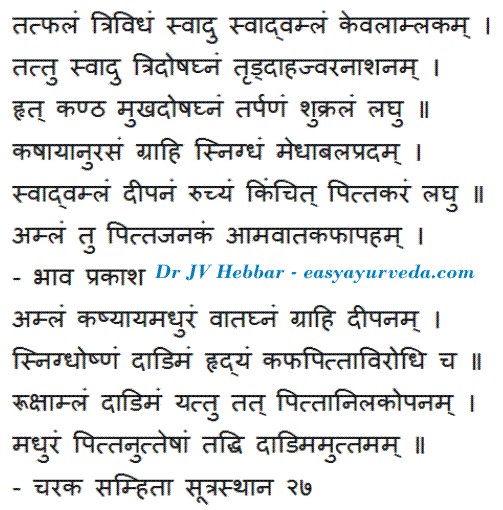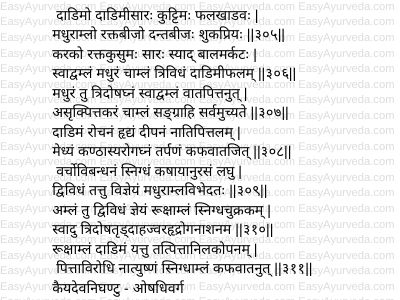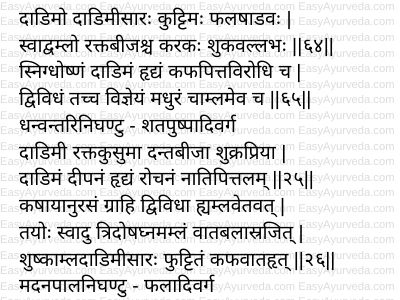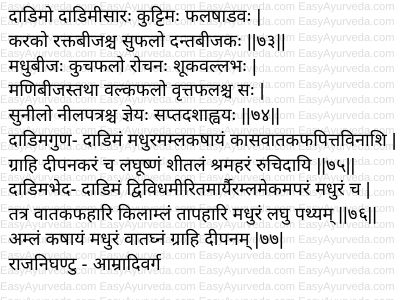Pomegranate Benefits, Home Remedies, Side Effects
Pomegranate fruit benefits are innumerable. There are only a very few fruits as nutrition-loaded as pomegranate. Pomegranate has been used for its health benefits for thousands of years. Apart from pomegranate fruits, other parts of the plant such as bark, root bark are also used in many health conditions. Pomegranate fruit is the widely used part of the plant.

Table of Contents
Qualities, effect on Doshas
Guna (qualities) – Laghu (light to digest), Snigdha (unctuous, oily)
Rasa (taste) – Madhura (sweet), Amla (sour), Kashaya (astringent)
Vipaka (taste conversion after digestion) – Madhura (sweet) or Amla (sour)
Veerya (potency) – Anushna – neither cold, nor sweet.
Pomegranate – effect on Tridosha –
Sweet pomegranate balances Tridosha – Vata, Pitta and Kapha
Sour pomegranate balances Vata and Kapha and increases Pitta.
Morphology
Habit – A large deciduous shrub or small tree
Bark – Smooth, gray and thin, with axillary or terminal thorns
Leaves – Opposite, oblong lanceolate, shining above, bright green beneath
Flower – Solitary, red coloured with numerous stamens, inferior ovary
Fruit – Globose
Seeds – With a watery outer coat, with pink juice and a horney inner coat
Useful parts
Phala twak (Rind)
Kandamula Twak (Stem and Root bark)
Pushpa (Flowers)
Matra (Dose)
Phala Rasa (Juice) – 20 – 50 ml
Phala twak kwatha (Decoction) – 40 – 80 ml
Sanskrit Verses




Pomegranate fruit benefits
In south India, it is mixed with curd rice and consumed. It helps to aid in digestion. Qualities of pomegranate fruits are explained in Ayurveda based on its taste. Based on taste, it is classified into three categories.
Sweet pomegranate
Sweet pomegranate fruit benefits – Sweet pomegranates are having the rarest Tridosha balance effect. There are only a handful of herbs with Tridosha balance effect. (Amla fruit is another example)
The sweet pomegranate fruit is indicated to be taken during fever.
Trit hara, Daaha hara – It relieves excessive thirst and burning sensation.
It cleanses and clarifies the oral cavity, throat, esophagus, stomach and chest.
Shukrala – It is a good natural aphrodisiac and improves sperm count and semen quality.
Laghu – It undergoes digestion very easily, very light on stomach.
It also has an astringent taste, helps to relieve diarrhea, useful in IBS, ulcerative colitis.
Medha balakara – It improves intelligence, immunity and body strength.
Hridya – Good for heart
Sweet-sour pomegranate
Sweet-Sour Pomegranate fruit benefits- Pomegranates having sweet and sour taste improves digestion power of the stomach.
Ruchya – Helps relieve anorexia, improves the taste of food.
It slightly increases Pitta.
Sour pomegranate
Sour pomegranate fruit – Pomegranate fruit having predominant sour taste increases Pitta to a greater extent. Hence, it is not indicated in bleeding disorders. But it balances Kapha and Vata. Sour pomegranate is an ideal ingredient of diet in Rheumatoid arthritis.
Pomegranate benefits – Modern views
Modern science hails pomegranate benefits in many ways. Pomegranate is a proven rich source of antioxidants, hence it is very good for the heart. It is interesting to know that this finding matches with Hridya – protecting and promoting heart health claims by centuries old Ayurveda matches with the scientific research.
Pomegranate fruit is a good source of Vitamin C, B5, Polyphenols and Potassium.
Pomegranate benefits in wikipedia
It augments the digestive fire, is wholesome to the body; provides virility; relieves vomiting, loss of taste, inflammations and pitta type of fever. Soothes from the burning sensation inside the body, improves complexion of skin, provides physical energy, provides satiation when consumed in its ripened state. It at times acts as an absorbent in a milder form, it soothes the throat in a person with cough.
Pomegranate Peel Benefits
How to use pomegranate peel for good health?
Dr JV Hebbar
Pomegranate peel tea is useful in the treatment of diarrhea and is a common remedy for irritable bowel syndrome. To prepare its tea, 1 tablespoon of pomegranate fruit skin is added with a cup of water, boiled for 3 minutes, filtered and served lukewarm. Pomegranate peel powder or tea is useful in relieving stress, to improve heart health, to decrease Pitta dosha, burning sensation and high blood pressure. (research).
It is useful to treat acne and excessive oiliness of skin.
It is useful to reduce bad cholesterol.
Its decoction gargling is useful to decrease throat irritation and to clear voice.
Its peel powder is mixed with sandalwood and applied as facepack on skin to improve skin tightness and to relieve wrinkles.
Pomegranate with ghee
Pomegranate plus ghee is used for what?
JV Hebbar
Pomegranate balances Pitta dosha and is extremely useful in gastric erosion, bloating, acid peptic disorders and GERD and gastritis. Pomegranate also has wound / ulcer healing properties.
Ghee is useful to soothe the mucosal lining of the stomach and intestines.
So, half a cup of pomegranate with 1 – 2 teaspoon of ghee is usually recommended once or twice a day, 30 minutes before food in treating IBS with diarrhea, ulcerative colitis, peptic ulcers and gastritis.
Read: IBS – Ayurvedic treatment
Chemical composition
Pomegranate consists bioactive constituents such as hydrolyzable tannins, ellagic acid and its derivatives, gallic acid, anthocyanins, proanthocyanidins, flavonoids, vitamins, sterols, lignans, saccharides, fatty acids, organic acids, terpenes, and terpenoids
Pharmacological activity
Punica granatum consists of antioxidant, anticarcinogenic, anti-inflammatory properties, anti bacterial, antimicrobial, anti fungal, anti hypertensive and antiproliferative properties
Distribution
Punica granatum is native to Iran. It is cultivated throughout India
Morphology
Punica granatum is a large deciduous shrub. Bark is smooth and gray in color. Leaves are arranged opposite, glabrous above and dark green beneath. Flowers are small, short or without peduncle and reddish in color. Fruit is a berry, reddish in color, globose, odorless containing numerous seeds. Each seed is triangular in shape, covered with a watery outer coat containing pink juice.
Classical categorization
Kaiyadeva Nighantu – Aushadi varga
Raja Nighantu – Aamradi varga
Dhanvantari Nighantu – Shathapushpadi Nighantu
Madanaphala Nighantu – Phaladi varga
Side effects
Pomegranate side effects – It is known to cause constipation, hence is used as a home remedy for diarrhea. But people with constipation need to watch out.
Types of Pomegranate
- Amla dadima
- Madhura dadima
According to Kaiyadeva nighantu Amla dadima is of two types –
1. Ruksha amla
– Pitta anila kopanam – Causes increase in pitta and vata dosha
2. Snigdha amla
– Pitta avirodhi – It does not cause imbalance in pitta dosha
– Na ati ushna – Neither cold nor hot
– Balances excess kapha and vata dosha.
According to Bhavaprakasha Nighantu, there are 3 types –
- Swadhu
- Swadhu amla
- Kevala amla
Interaction with medicines, supplements
Can this be used while taking Homeopathic medicine?
Yes. This product does not react with homeopathic medicine.
Can this medicine be continued while taking supplements like multivitamin tablets, Omega 3 fatty acids etc?
Yes. Generally, this product goes well with most dietary supplements. However, if you are taking more than one product per day, please consult your doctor for an opinion.
With western medicines
Seek your doctor’s advice if you are taking this product along with other western (allopathic / modern) medicines. Some Ayurvedic herbs can interact with modern medicine.
If both Ayurvedic and allopathic medicines are advised together, then it is best to take Allopathic medicine first, wait for 30 minutes and then take the Ayurvedic medicine.
Research
Anti – obesity activity – The study on ‘Evidence of anti-obesity effects of the pomegranate leaf extract in high-fat diet induced obese mice’ have concluded that pomegranate leaf extract can inhibit the development of obesity and hyperlipidemia in high-fat diet induced obese mice. Thus the study proves pomegranate leaf extract has a significant effect on obesity due to a high fat diet.
Remedies for dysentery, bradycardia
Pomegranate for dysentery
The outer fruit cover of Pomegranate (Punica granatum) is made into a decoction and administered (15-20 ml) repeatedly.
Its leaf decoction for food poisoning, diarrhea – Its leaves – dried and powdered. Taken in one tablespoon quantity, added with a cup of water, boiled for 5 – 10 minutes. Filtered. It is advised along with a little honey, in a dose of 30 ml, twice a day, before food for 5-7 days.
Pomegranate remedy for bradycardia:
In case of low pulse rate, Vaidyaraj Subhash Sharma has mentioned about the below remedy:
Akarakara churna is mixed along with Pushkaramoola churna, Shrunga Bhasma and Vamsha lochana. It is administered one hour before food along with pomegranate juice, twice a day. Consult a doctor before following this or any other remedies.
Ayurvedic medicines
Ayurvedic products with Pomegranate as an ingredient –
Herbal powders:
Dadima Chatusama churna,
Dadimashtaka churna,
Lavan Bhaskar Churna
Alcoholic preparation: Mritasanjeevani Sura
Ghee preparation: Dadimadi Ghrita
Herbal powder – Yavanyadi choorna
Ayurvedic medicine, traditionally advised along with pomegranate juice is – Narayana Churna
Pomegranates, raw
Taste – sweet, astringent
Properties – light, unctuous
Potency – not very hot
After digestion taste transformation (Vipaka) – sweet, sour
Effect on Doshas
Vata balancing
Pitta balancing
Kapha balancing
Pomegranate juice, bottled
Taste – sweet, astringent
Properties – light, unctuous
Potency – not very hot
After digestion taste transformation (Vipaka) – sweet, sour
Effect on Doshas
Vata balancing
Pitta balancing
Kapha balancing
Sthanika Karma (Systemic Action)
External Application – Its bark decoction is beneficial in throat and mouth disorders for gargling. It also has wound healing properties.
Internal administration-
Nervous system – Act as a brain tonic. Strengthens the nervous system.
Digestive System – Absorbent and Carminative. Root bark has potent Anti microbial action, especially in Tapeworm infestation. Indicated in Anorexia, Loss of appetite, Excessive thirst, Acid reflux disease etc. Pacifies pitta dosha. In case of Diarrhea in kids; its flower bud along with milk can be administered. In worm infestation; its root bark decoction is administered on an empty stomach and fasting for one day and next day Virechana (Purgation Therapy) can be performed. This procedure helps to eliminate worms from the intestine.
Circulatory System – Heart protective, Indicated in Anemia, Bleeding disorders etc.
Respiratory system – Flower bud decoction helps to pacify kapha dosha, and fruit helps to eliminate excess kapha dosha from the body. Fruit is indicated in the cough of vata pitta origin. Reduces the dryness of the respiratory tract.
Excretory System – Indicated in Dysuria. Reproductive system –Improve the quality and quantity of seminal fluid. (Sukravardhaka)
Satmikarana –Fruit juice is highly beneficial in general debility. Promotes body strength.
Tvak (Skin) – Indicated in skin diseases, reduces burning sensation.
Tapakrama – Helps to reduce fever and associated symptoms, also improves the strength of the patient.
Common names, Sanskrit synonyms
Hindi name: Anar
Telugu name: Danimma Kaya, daalimba, daanimma.
Malayalam name: Matalam, matalam, madala, raktabijam
Tamil name: Matuli, maadulai, maatulai pazham.
Marathi name: Dalimb
Kannada name: Dalimbe hannu
Urdu name – Urdu: aab-e-amar, amrdana.
Persian name – anar.
Arabic name – gulnar
Hindi name – anar ke phal.
Sanskrit synonyms of Pomegranate:
Phalamla – has slightly sour taste
Kuchaphala – Fruit resembles the shape of breasts
Shukavallabha, shukapriya – attracts birds
Raktabeeja – has red seeds
Raptapushpa, Raktakusuma, Lohitapushpaka – has red coloured flowers
Dantabeeja – seeds are arranged like teeth
Baalamarkata
Kuttima
Phalashadava
Karaka
Daadimisarah
Madhubeeja – seeds are sweet
Manibeeja – Seeds like quartz or ruby
Valkaphala – Fruits covered by leathery rind
Rasalaka – Fruit is juicy
Vrintaphala – fruit is globose
Suneelo
Neelapatra
Pathyakari – Conductive to health
Karaka – Useful in many disease
Botanical classification
Kingdom – Plantae
Division – Magnoliophyta
Class – Dicotyledon
Sub class – Sapindales
Order – Rosidae
Family – Rutaceae
Sub family – Aurantoideae
Genera – Citrus
Sub genera – Papeda
Species – Sinensis











30 comments
anand
great!
jenny
hi ..
can pregnant lady take pomegranate during their pregnancy ? is it true can make child look radiant by taking this fruit??
Ananth
I am regualrly taking pomogranate juice 300 ml per day – finding it very good
sangeetha
how good is eating a pomegranate fruit useful for type II diabetic patients
Dr J V Hebbar MD(Ayu)Author
It is very useful in the following ways.
1. Pomegranate is rich in anti oxidants, hence keeps the internal organs healthy and strong. Keeps the energy levels up in diabetics.
2. Pomegranates strengthen vessel walls and induces quick healing of wounds, and hence helpful in diabetes, where wounds take a long time to heal.
Gaurav
Along with other regular spices in tadka while cooking daal/vegetables, does putting ‘anardaana’ help? What are its benefits?
Dr J V Hebbar MD(Ayu)Author
Because Anar daana is a fruit that can be readily used, I do not think frying it in the form of tadka is required. Even in many Indian dishes, wherever it is used, it is used fresh.
Hari
What action does pomegranate have on liver, acidity, h pylori and other pathogens ?????
Dr J V Hebbar MD(Ayu)Author
Pomegranate is a very good liver tonic. hence, is an ingredient of Mathala Rasayana, useful in liver diseases – http://ayurmedinfo.com/2012/12/02/mathala-rasayanam-benefits-dosage-ingredients-side-effects/
It has calming effect over stomach, hence relieves gastritis and hyper-acidity. It is useful in diarrhoea and IBS.
Because of its ellagic acid content, it is equally useful in H Pylori infection.
Vishnu
Patanjali digestive pachak anardana increases dogestive power but will it increse pitta at the same time??
Dr J V Hebbar MD(Ayu)Author
Anar Dana – sweet pomegranate calms Pitta.
Hence, Patanjali Pachak Anardana though increases digestion strength, the sweetness of pomegranate would avoid excess increase of Pitta Dosha.
Shubham
Dear Dr Hebbar,
What is better for constipation in Kapha/Pitta individial – Apple or pomegranates?
Which of above create for more Vata?
Thanks
Raj
Can we take triphala with milk, since triphala contains amla and amla (being sour) is incompatible with milk. Thanks.
Dr J V Hebbar MD(Ayu)Author
No. Triphala with milk is not acceptable.
Kamal
Hi doctor,
You mention that pomegrante and amla are the few foods that balance all 3 doshas. Please provide us with a list of the remaining foods that balance all 3 doshas.
Thanks
Dr J V Hebbar MD(Ayu)Author
Will write about them soon.
ramabadran
can diabetic person take one pomogranate fruit a day if diabetic person eats a pomogranate a day, his / her blood sugar will increase
Dr J V Hebbar MD(Ayu)Author
He can have half a fruit a day.
V.R.K. Raman
V.R.K. Raman.
Query from: Your answer.
1. Shubam. Triphala can be taken with a
cup of milk at night after food.
2. Raj. Triphala is not to be taken with milk.
Pl. clarify.
Thanking you
Dr J V Hebbar MD(Ayu)Author
Triphala cannot be taken with milk. It can be taken only with water.
ABU SAAD
Thank you Dr for your phenomenal contributions to the public interest.
Could you suggest some food items like Amla and pomegranate that balance all the doshas simultaneously .
Thank You
Dr J V Hebbar MD(Ayu)Author
Triphala, haritaki fruit, rock salt etc. But we need not go behind just the Tridoshic items.
A food combination with some Vata balancing, some pitta balancing and some kapha balancing items, combined together is also very good.
ABU SAAD
Thank you for your kind Insights
Prommila
I have digestion issues. It takes 2 to 5 times to clear the stomach (also bloating, gas). Can I eat pomegranate instead of dinner? Half pomegranate?
Dr J V Hebbar MD(Ayu)Author
Yes.
Devendra pratap
Is pomegranate peel powder is equally good for digestive issues…?? How to take that
Dr J V Hebbar MD(Ayu)Author
It is more useful in IBS, gas formation and Diarrhea.
A tablespoon of powdered peel is added with a cup of water, boiled for 2 minutes, filtered and consumed when still lukewarm. This can be consumed by adults, once or twice a day.
Bharat
Hi Sir,
Can we have pomegranate in empty stomach in the evening?
Thank You
Dr J V Hebbar MD(Ayu)Author
Yes